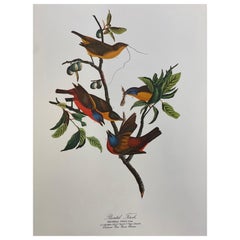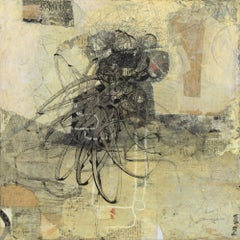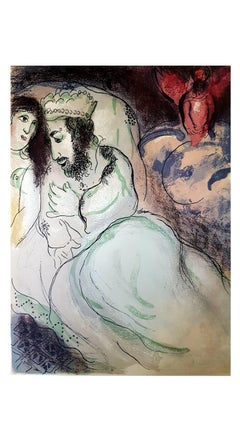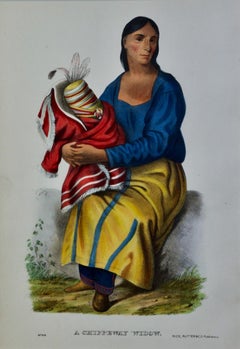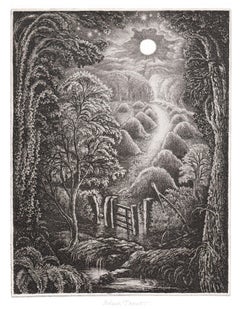Miniature More Prints
to
215
2,339
1,735
2,255
1,010
795
Overall Width
to
Overall Height
to
389
366
204
175
88
30
25
24
23
18
14
11
5
1
130
83
35
34
34
104
381
1,427
427
17
8
28
51
61
150
264
270
159
86
81
1,566
606
154
64
41
28
23
16
13
12
12
7
7
7
6
5
4
4
4
3
3
3
3
992
450
414
182
172
165
551
1,107
747
Size: Miniature
Large Classical Bird Color Print after John James Audubon, Painted Finch
Located in Cirencester, Gloucestershire
Classical Bird print,
after John James Audubon,
printed by Harry N. Abrams, Publishers, New York
unframed, 17 x 14 inches color print on paper
condition: very good
provenance: from...
Category
20th Century Victorian More Prints
Materials
Acrylic
Monkey Mind
Located in San Francisco, CA
Paula Valenzuela
Monkey Mind, 2019
Giclée archival inkjet print on watercolor paper
Unframed dimensions: 15 x 15 inches
Framed dimensions: 17.12 x 17.12 inches
Edition of 10
Limited...
Category
21st Century and Contemporary Abstract Abstract Prints
Materials
Paper, Archival Ink, Giclée
Marc Chagall - The Bible - Sarah And Abimelech - Original Lithograph
By Marc Chagall
Located in Collonge Bellerive, Geneve, CH
Marc Chagall, Original Lithograh depicting an instant of the Bible.
Technique: Original lithograph in colours (Mourlot no. 234)
On the reverse: another black and white original litho...
Category
1960s Modern Figurative Prints
Materials
Lithograph
A Chippeway Widow: An Original 19th C. Hand-colored McKenney & Hall Lithograph
Located in Alamo, CA
This an original 19th century hand colored McKenney and Hall Lithograph of a Native American entitled "A Chippeway Widow, No. 64", published by Rice, Rutter & Co. in 1865.
Her name ...
Category
Mid-19th Century Naturalistic Portrait Prints
Materials
Lithograph
Jean Cocteau - Portrait - Original Lithograph
By Jean Cocteau
Located in Collonge Bellerive, Geneve, CH
Original Lithograph by Jean Cocteau
Title: Taureaux
Signed in the plate
Dimensions: 40 x 30 cm
Edition: 200
Luxury print edition from the portfolio of Trinckvel
1965
Jean Cocteau
W...
Category
1960s Modern More Prints
Materials
Lithograph
Full Moon, Robin Tanner signed artist etching
By Robin Tanner
Located in Melbourne, Victoria
Full Moon
Etching by Robin Tanner (1904-1988), signed by the artist in pencil.
Very good, strong impression with excellent contrast. From the edition issued in 1977.
Robin Tanner’...
Category
1970s English School Landscape Prints
Materials
Etching
Living Painting - Colour Pochoir
Located in Collonge Bellerive, Geneve, CH
Full-page, colour pochoir after costume designs by Sonia Delaunay.
Edition 331/500 copies on Velin Aussedat
Dimensions: 28.5 x 19.5 cm.
From 27 Living Paintings. [Milano, Edizioni d...
Category
1960s Abstract Geometric Figurative Prints
New Zealand War Canoe: Original 18th C. Engraving from Captain Cook's 1st Voyage
Located in Alamo, CA
"War Canoe of New Zealand, with a View of the Gable End Foreland" is an engraving created by Thomas Prattent, from a drawing by Sydney Parkinson, who was the artist on Captain James ...
Category
1780s Landscape Prints
Materials
Engraving
L'atelier de Cannes
Located in OPOLE, PL
This work will be exhibited at Art on Paper NYC, September 4–7, 2025.
–
Pablo Picasso (1881-1973) - L'atelier de Cannes
Lithograph from 1958.
On Arches paper.
Dimensions of work...
Category
1950s Modern Figurative Prints
Materials
Lithograph
Congregational Church, Old Lyme, CT. (quintessential New England landmark)
Located in New Orleans, LA
The Old Lyme Congregational Church located on Ferry Road, a quintessentially New England landmark, was captured by Walter DuBois Richards. The church was a favorite subject of Old Ly...
Category
Late 20th Century American Modern Landscape Prints
Materials
Lithograph
"Yer Blues" Limited Edition Hand Written Lyrics
By John Lennon
Located in Laguna Beach, CA
Rare Limited Edition Serigraph of John Lennon's handwritten lyrics for the song "Yer Blues" first released on the Beatles "White Album" in 1968. This limited edition was released by...
Category
1990s Contemporary More Prints
Materials
Other Medium
Young Mahaskah, An Ioway Chief: Original Hand-colored McKenney & Hall Lithograph
Located in Alamo, CA
This an original 19th century hand colored McKenney and Hall engraving of a Native American entitled "Young Mahaskah, An Ioway Chief, No. 80", published by Rice, Rutter & Co. in 1865...
Category
Mid-19th Century Naturalistic Portrait Prints
Materials
Lithograph
Shau-Hau-Napo-Tinia, Ioway Chief: A 19th C. Hand-colored McKenney & Hall Litho
Located in Alamo, CA
This is an original 19th century hand-colored McKenney and Hall lithograph of a Native American entitled "Shau-Hau-Napo-Tinia, An Ioway Chief", lithographed by J. T. Bowen after a pa...
Category
Mid-19th Century Naturalistic Portrait Prints
Materials
Lithograph
Ap-Pa-Noo-Se, A Saukie Chief: Original Hand-colored McKenney & Hall Lithograph
Located in Alamo, CA
This is an original 19th century hand-colored McKenney and Hall lithograph of a Native American entitled "Ap-Pa-Noo-Se, A Saukie Chief", lithographed by J. T. Bowen after a painting ...
Category
Mid-19th Century Naturalistic Portrait Prints
Materials
Lithograph
Orignal "Le Vrai Camembert de Normandie" vintage French cheese poster
Located in Spokane, WA
Original French poster: Camembert, E. PAILLAUD lithograph. Artist: Andre Roland. Size: 12.75" x 17.75" Archival linen backed and in excellent condition; ready to frame. The ...
Category
1950s American Modern Figurative Prints
Materials
Lithograph
Primula Sinensis, English antique flower chromolithograph, 1896
Located in Melbourne, Victoria
'Primula Sinensis'
Antique English flower botanical chromolithograph.
Category
Late 19th Century Naturalistic Still-life Prints
Materials
Lithograph
Hommage à San Lazzaro - Lithograph by M. Chagall - 1975
By Marc Chagall
Located in Roma, IT
Hommage à San Lazzaro is a lithograph realized by Marc Chagall for the Art Revew "XXème Siècle".
This original print (not signed and not numbered) comes from the portfolio Hommage à...
Category
1970s Surrealist Figurative Prints
Materials
Lithograph
North & South America: A 17th Century Hand-colored Map by Jansson & Goos
Located in Alamo, CA
A 17th century hand-colored map of North & South America entitled "Americae Descriptio" by the cartographer Johannes Jansson, published in Jansson's Atlas Minor in Amsterdam in 1628....
Category
1620s Landscape Prints
Materials
Engraving
Maryland and Delaware. USA. Century Atlas state antique vintage map
Located in Melbourne, Victoria
'The Century Atlas. Maryland and Delaware.'
Original antique map, 1903.
Central fold as issued. Map name and number printed on the reverse corners.
Sheet 29.5cm by 40cm.
Category
Early 20th Century Victorian More Prints
Materials
Lithograph
Album Soft Telephone
Located in Hollywood, FL
ARTIST: Salvador Dali
TITLE: Album Soft Telephone
MEDIUM: Etching
SIGNED: Hand Signed
EDITION NUMBER: 15/150
MEASUREMENTS: 11" x 15"
YEAR: 1968
FRAMED: Yes, framed in a lucit...
Category
1960s Surrealist More Prints
Materials
Etching
Jacob Pleurant La Mort de Son Fils Joseph (B38), Heliogravure by Rembrandt
Located in Long Island City, NY
Artist: Rembrandt van Rijn, After by Amand Durand, Dutch (1606 - 1669) - Jacob Pleurant La Mort de Son Fils Joseph (B38), Year: 1878 (of original 1633), Medium: Heliogravure, Size: ...
Category
Late 19th Century More Prints
Materials
Etching
Six Inches Four Ways in the original colophon envelope, pencil numbered 917/1000
Located in New York, NY
Sylvia Plimack Mangold
Six Inches Four Ways
1976
Rubber stamp print on Kilmurray paper
Stamp made by Unity Engraving Company, Inc.
Printed by A. Colish Press
Paper size: 8 x 8 inches...
Category
1970s Abstract Abstract Prints
Materials
Lithograph
Birds of Paradise, German antique natural history chromolithograph print
Located in Melbourne, Victoria
'Paradiesvogel'
(Birds of Paradise)
German chromolithograph, circa 1895.
240mm by 155mm (sheet)
Category
Late 19th Century Naturalistic Animal Prints
Materials
Lithograph
The Magician with Bulls
Located in OPOLE, PL
Pablo Picasso (1881-1973) - The Magician with Bulls
Phototype and pochoir from 1962.
From the edition of 1,000 copies, this example is number 334, as noted in the colophon.
Dimens...
Category
1960s Modern More Prints
Materials
Stencil
French Mid-Century 1970s Fashion Design Vintage Lithograph Print
Located in Melbourne, Victoria
Original colour lithograph of a French fashion design from 'Haute Couture'. Published in a folio of designs for Summer 1971.
32cm by 22cm (sheet)
Category
1970s Post-War Figurative Prints
Materials
Lithograph
The Old Road: Elegy for the English Elm I, Robin Tanner signed artist etching
By Robin Tanner
Located in Melbourne, Victoria
The Old Road: Elegy for the English Elm I
Etching by Robin Tanner (1904-1988), signed by the artist in pencil.
Very good, strong impression with excellent contrast. From the editio...
Category
1970s English School Landscape Prints
Materials
Etching
The Man in Love, from: Masters Portfolio of the Staatliches Bauhaus - German
By Paul Klee
Located in London, GB
This original lithograph in colours is hand signed in pencil by the artist "Klee" at the lower right margin.
Our impression is from the third and final state of this lithograph which...
Category
1920s Bauhaus More Prints
Materials
Lithograph
Floating Diyas, Woodcut on Paper, Figurative by Haren Das "In Stock"
By Haren Das
Located in Kolkata, West Bengal
Haren Das - Untitled (Floating diyas)
Woodcut on Paper
6 x 8 inches
( Unframed & Delivered )
Born in Dinajpur in present day Bangladesh on 1 February 1921, Das took a diploma in fin...
Category
1990s Modern Figurative Paintings
Materials
Paper, Woodcut
Mark Drew — Business Kid (Gangstarr), Blue Variant (2025)
By Mark Drew
Located in Draper, UT
Mark Drew — Business Kid (Gangstarr), Blue Variant (2025)
In this striking blue variant of Business Kid (Gangstarr), Mark Drew marries nostalgic comic imagery with hip-hop lyricism ...
Category
2010s Street Art More Prints
Materials
Screen
Untitled, Jasper Johns. Colorful rainbow hatching on parchment
By Jasper Johns
Located in New York, NY
This print features Johns's exuberant hatching in orange, white, bright green, and purple atop collaged newsprint. Printing on translucent parchment makes the image particularly vibr...
Category
1970s Abstract Abstract Prints
Materials
Screen
Chow and Pekinese (Pekingnese), Cecil Aldin 1930s puppy dog lithograph
Located in Melbourne, Victoria
'Chow and Pekinese' (Pekingnese)
Cecil Aldin dog lithograph, 1935.
Cecil Aldin was a British artist and illustrator best known for his paintings and sketches of animals, sports, an...
Category
1930s English School Animal Prints
Materials
Lithograph
Ficción Astronómica 3
By Jaime Colín
Located in Cuernavaca, Morelos
Digital print on cotton paper
Category
2010s Contemporary More Prints
Materials
Cotton, Paper, Digital
The Taste of Happiness, Planche XXXVIII
Located in OPOLE, PL
Pablo Picasso (1881-1973) - The Taste of Happiness, Planche XXXVIII
Lithograph from 1970.
An unsigned and unnumbered edition of 666.
Dimensions of sheet: 32.5 x 25 cm
Dimensions ...
Category
1970s Modern More Prints
Materials
Lithograph
Telemachia, from Ulysses
Located in Washington, DC
Artist: Robert Motherwell
Title: Telemachia - Odyssey - Nostos
Medium: Etching on Johannot paper
Date: 1988
Edition: 27/40
Sheet Size: 13" x 10"
Signature: Initialed (RM) in pencil
Category
1980s Abstract Abstract Prints
Materials
Lithograph
French Mid-Century 1970s Fashion Design Vintage Lithograph Print
Located in Melbourne, Victoria
Original colour lithograph of a French fashion design from 'Haute Couture'. Published in a folio of designs for Summer 1971.
32cm by 22cm (sheet)
Category
1970s Post-War Figurative Prints
Materials
Lithograph
'Favourite Flowers' Limited edition book with signed aquatint 'Salpiglossis'
Located in Llanbrynmair, GB
’Favourite Flowers (Salpiglossis)’
By Elizabeth Blackadder
A limited edition book of 100 copies specially bound for the Mercury Gallery. No 1 to 50 contain and original etching/aquatint 'Iris'. No 51 to 100 contain and original etching/aquatint 'Salpiglossis'. Each signed and numbered by the artist. All watercolours reproduced within the book by Elizabeth Blackadder and commentary by Deborah Kellaway.
Medium - Limited edition book with signed aquatint
Book Edition - 58/100
Print Edition - 8/50
Signed Book - Yes
Signed Print - Yes
Size Book - 234mm x 202mm
Size Print - 217mm x 187mm
Date - 1994
Published by Gillian Raffles. Mercury Gallery. Bond Street, London
Condition - Excellent. 10/10
Painter and printmaker, born Falkirk, Scotland. She studied at Edinburgh University and Edinburgh College of Art, 1949-54. In 1954 she was awarded a Carnegie Travelling Scholarship and visited Yugoslavia, Greece and Italy and was much influenced by Byzantine architecture and mosaics. In 1956 she married the painter John Houston with whom she has since travelled widely. Flowers, cats and small objects are often arranged perpendicularly across the paper or canvas.
Elected RSW in 1960, an Associate of the RSA 1963, an Associate of the RA 1971, RSA 1972 and RA 1976, she is the first woman to be elected both RA and RSA. Blackadder has exhibited at the Mercury Gallery, London, Marjorie Parr Gallery and abroad and is a member of the Scottish Arts Club. Her work is represented in Aberdeen University, Bolton Art Gallery, Brighton and Hove Museums and Art Galleries, City Arts Centre, Edinburgh, Fleming Collection, Glasgow Print Studio, Gracefield Arts Centre, New Hall College, Cambridge, Otter Gallery, Reading Art...
Category
Late 20th Century Contemporary More Prints
Materials
Color, Etching, Aquatint
Tête penchée et Bocal de Poissons
Located in London, GB
Etching on Chine appliqué on Arches Velin paper, Edition of 25
Paper size: 28.5 x 38 cms (11 1/4 x 15 ins)
Plate size: 14.9 x 19.6 cms (5 7/8 x 7 5/8 ins)
Category
1920s Impressionist Portrait Prints
Materials
Etching
Arrest the Murderer - 1853 Broadside, Harris County, Texas
Located in Middletown, NY
A 1853 Broadside advertising a large reward for the apprehension of accused murderer John Hide of Harrison County, Texas.
Broadside poster printed in black ink on cream-colored wove...
Category
Mid-19th Century American Realist More Prints
Materials
Printer's Ink
Ficción Astronómica 2
By Jaime Colín
Located in Cuernavaca, Morelos
Digital print on cotton paper
Category
2010s Contemporary More Prints
Materials
Cotton, Paper, Digital
Ficción Astronómica 4
By Jaime Colín
Located in Cuernavaca, Morelos
Digital print on cotton paper
Category
2010s Contemporary More Prints
Materials
Cotton, Paper, Digital
歌麿筆Utamaro Hitsu as Sealed-From Six Houses of Yoshiwara-Publisher Omiya Gonkuro
Located in London, GB
-In light of new tariffs, we’ve applied a 20% discount off the market price of this piece to support our collectors in facing potential added costs. At the gallery, we work closely w...
Category
1990s Edo More Prints
Materials
Ink, Washi Paper, Woodcut
Capital Tanager, 18th century bird engraving by John Latham
By John Latham
Located in Melbourne, Victoria
Copper-line engraving. 1781. From John Latham's 'General Synopsis of Birds' 1781-1785, and its Supplements. Plate number top left. Laid paper.
John Latham was the leading English or...
Category
Late 18th Century Naturalistic Animal Prints
Materials
Engraving
Vallauris
Located in OPOLE, PL
Pablo Picasso (1881-1973) - Vallauris
Lithograph from 1954.
Dimensions of work: 35.5 x 26.5 cm
Publisher: Tériade, Paris.
The work is in Excellent condition.
Fast and secure shi...
Category
1950s Modern Figurative Prints
Materials
Lithograph
Jean Cocteau - Bull - Man - Original Lithograph
By Jean Cocteau
Located in Collonge Bellerive, Geneve, CH
Original Lithograph by Jean Cocteau
Title: Taureaux
Signed in the plate
Dimensions: 40 x 30 cm
Edition: 200
Luxury print edition from the portfolio of Trinckvel
1965
Jean Cocteau
W...
Category
1960s Modern More Prints
Materials
Lithograph
Jennifer Jokhoo, Riverbank SE1 (Petrol), London Art, Affordable Art, Cityscape
Located in Deddington, GB
Jennifer Jokhoo
Riverbank SE1 (Petrol)
Limited Edition Handmade Reduction Linocut Print
Edition of 15
Sheet Size: H 20cm x W 20cm x D 0.1cm
Sold Unframed
Please note that in situ ima...
Category
21st Century and Contemporary Contemporary Landscape Prints
Materials
Paper, Linocut
Vinyl Collection A Side Recording - Pop Art Color Photography
Located in Cambridge, GB
'A Side Recording'. Acclaimed contemporary photographers, Richard Heeps and Natasha Heidler have collaborated to make this beautifully mesmerising collection. A celebration of the vi...
Category
2010s Pop Art Color Photography
Materials
Photographic Paper, C Print, Color, Silver Gelatin
Adolph Willette “Cacao Van Houten” Original 1896 Poster Chaix
Located in Dallas, TX
Willette- Maitres de L'affiche: Cacao Van Houten, original lithograph 1896, Impremie CHAIX. PL. 43 France, 1890-1919, paper
Willette: Cacao Van Houten
Original stone Lithograph on vélin paper 1896
Sheet Size: 15.75 x 11.4 in. / 39.5 x 29 cm
Printed by: Imprimerie Chaix 1896
In very good condition (A) unbacked,
This plate is from the famous set "Les Maitres de l'affiche"
The "Les Maitres de l'Affiche" series was offered as a subscription series to collectors. Every month for 60 months, from December 1895 through November 1900, subscribers received by mail, 4 loose sheets (Maitres) with a cover sheet.
Willette's elegant vertical poster...
Category
1890s Art Nouveau More Prints
Materials
Paper
La bataille (D. 118)
By Hans Bellmer
Located in OPOLE, PL
Hans Bellmer (1902-1975) - La bataille (D. 118)
Etching from 1958.
Edition of 99/100.
Dimensions of work: 38 x 28 cm.
Hand signed.
--
Published by Joseph Foret, Paris, 1958.
L...
Category
1950s Expressionist More Prints
Materials
Etching
Fruitful (small)
By Damien Hirst
Located in London, GB
Damien Hirst
Fruitful (small), 2020
Laminated Giclée print on aluminium composite panel
Digitally signed by the artist
39 x 39 cm
Edition of 3308
The editions titled Fruitful f...
Category
2010s Contemporary Abstract Prints
Materials
Giclée
Po-Ca-Hon-Tas: Original Hand-colored McKenney & Hall Lithograph
Located in Alamo, CA
This is an original 19th century hand-colored McKenney and Hall lithograph of a Native American entitled "Po-Ca-Hon-Tas", lithographed by J. T. Bowen after a painting by Charles Bird...
Category
Mid-19th Century Naturalistic Portrait Prints
Materials
Lithograph
Alaska, United States of America, Century Atlas state antique vintage map
Located in Melbourne, Victoria
'The Century Atlas. Alaska.' Inset maps of 'Sitka, Glacier Bay' and Aleutian Is.'.
Original antique map, 1903.
Central fold as issued. Map name and number printed on the reverse cor...
Category
Early 20th Century Victorian More Prints
Materials
Lithograph
Trangle et Quadrilatere - Lithograph by Alexander Calder - 1973
Located in Roma, IT
Trangle et Quadrilatere is a Lithograph realized in 1973 by Alexander Calder.
From Derrière Le Miroir.
Very good condition including a white cardboard passpartout (52 x 41 cm).
Al...
Category
1970s Abstract More Prints
Materials
Lithograph
The Whitesmiths, Impresse des Carmelites
Located in Santa Monica, CA
JAMES ABBOTT MCNEILL WHISTLER (1834 – 1903)
THE WHITESMITHS, IMPRESSE DES CARMELITES 1894 (03) Way 53, LEVY 84
Transfer lithograph signed with butterfly in stone 8 ½ x 6 1//8". ...
Category
1890s Impressionist More Prints
Materials
Lithograph
$725 Sale Price
51% Off
Le Peintre et son Modèle II
Located in OPOLE, PL
Pablo Picasso (1881-1973) - Le Peintre et son Modèle II
Lithograph from 1954.
Dimensions of work: 35.5 x 26.5 cm
Publisher: Tériade, Paris.
The work is in Excellent condition.
F...
Category
1950s Modern Figurative Prints
Materials
Lithograph
La Comédie Humaine
Located in OPOLE, PL
Pablo Picasso (1881-1973) - La Comédie Humaine
Lithograph from 1954.
Dimensions of work: 35.5 x 26.5 cm
Publisher: Tériade, Paris.
The work is in Excellent condition.
Fast and s...
Category
1950s Modern Figurative Prints
Materials
Lithograph
Two lawyers from 'Croquis Parisiens'
Located in London, GB
This witty lithograph is by the 19th Century French satirist Honoré Daumier. The print portrays a pair of lawyers, both dressed for court, one lawyer furtively speaking to the other....
Category
Mid-19th Century Figurative Prints
Materials
Paper, Lithograph
Le-Soldat-Du, An Osage Chief: Original Hand-colored McKenney & Hall Lithograph
Located in Alamo, CA
This is an original 19th century hand-colored McKenney and Hall lithograph of a Native American entitled "Le Soldat-Du-Chene, An Osage Chief", lithographed by J. T. Bowen after a pai...
Category
Mid-19th Century Naturalistic Portrait Prints
Materials
Lithograph
A Night Dance by Women in Tonga: Original 18th C. Engraving, Cook's 3rd Voyage
By John Webber
Located in Alamo, CA
"A Night Dance by Women in Hapaee" is an original 18th century engraving from a drawing by John Webber (1751-1793), who was the artist who accompanied Captain Cook on his third voyag...
Category
1780s Landscape Prints
Materials
Engraving
Streptocarpus, English antique flower botanical chromolithograph, 1896
Located in Melbourne, Victoria
'Streptocarpus'
Antique English flower botanical chromolithograph.
Category
Late 19th Century Naturalistic Still-life Prints
Materials
Lithograph
Set of Four Framed Color Photography Americana Mid-Century Lifestyle Interiors
Located in Cambridge, GB
Set of four square framed artworks from Richard Heeps' Americana Dream in Color series featuring the classic American RV and three vignettes from its vintage interior, captured in Bi...
Category
Early 2000s Contemporary Color Photography
Materials
Photographic Paper, C Print, Color, Silver Gelatin
Recently Viewed
View AllMore Ways To Browse
Delta Poster
Ed Ruscha Sin With Olive
Ed Ruscha Sin
Ewan David Eason
Florida Vintage Travel Posters
Goodyear Poster
Gustav Klutsis
Ihap Hulusi
Ivan Navarro
James B Painter
James Bond Movie Posters
Jan V Roy Posters
John Lennon On Sale
Lait Pur Sterilize
Lake District Vintage Travel Poster
Land Rover Poster
Le Frou Frou Vintage Poster
Leon De Pas
